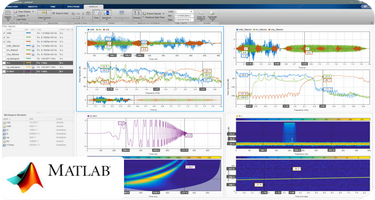MATLAB® (MathWorks) is a powerful and flexible multi-purpose programming platform for engineers and scientists from different academic, research and technical areas. MATLAB comprises a commercial numerical computing environment and a proprietary high-level matrix-based programming language.
Dr. Alexander Rukhlenko was one of the first SAW researchers and designers to apply MATLAB for modeling and designing SAW filters. Since 1993 he had been using MATLAB on the regular and systematic basis and contributed a lot into MATLAB computer-aided design of SAW devices.
He developed MATLAB SAW models, design techniques and algorithms, and comprehensive SAW software which effectively exploit vector/matrix and array mathematics. He contributed a lot into development and implementation of the optimization techniques for design of the classical SAW filters comprising two bidirectional SAW transducers. In particular, he was one of the first SAW designers to modify and apply to the practical design of SAW filters the Remez exchange algorithm programmed in Fortran and called in MATLAB as the MEX file. Later the optimal and suboptimal design of linear-phase SAW filters was generalized to SAW filters with arbitrary magnitude and phase responses.
He suggested and implemented the Iterative Weighted Least Squares (IWLS) approach which is much easier for MATLAB programming if compared to the Remez exchange algorithm. In its general form, the IWLS algorithm allows synthesis of SAW filters with specified arbitrary magnitude and phase/group delay characteristics. Besides, IWLS can be also applied to compensate iteratively second-order effects, for example, frequency response distortion due to the electrical load/matching.
Dr. Alexander Rukhlenko was the first SAW designer to introduce into SAW design practice the factorizational synthesis of SAW bidirectional filters resulting in the minimum SAW filter length. The technique was based on the search of the high-order Z-transform roots and their meaningful separation between input and output SAW transducers. He successfully applied this innovative design approach to win SAW Filter Design Competition organized and sponsored by SAWTEK Inc. (USA) in the former USSR in 1995. At the time, his proprietary MATLAB Z-transform root solver exhibited the superior performance over the standard MATLAB build-in functions in terms of speed, accuracy and numerical stability.
Dr. Alexander Rukhlenko is an author of the proprietary iterative techniques for designing SAW filters with arbitrary magnitude and phase responses without resorting to the time consuming non-linear programming. The proposed techniques dynamically recalculate the tolerance field for the next iteration based on the results of the previous iteration, with alternative optimization of the real and imaginary parts of the frequency response applied at each iteration.
He developed fast and accurate techniques for charge distribution and capacitance calculation of the apodized periodic SAW transducers with arbitrary polarity sequencies. The approach was later generalized to calculate admittance of the periodic apodized SAW transducers without resorting to the commonly-used time-consuming subdivision of the apodization pattern to the uniform (unapodized) tracks with the subsequent summation of the track contributions to the overall admittance.
He suggested a simple and elegant method to cascade SAW components in the quasi-static approximation which requires minimal programming effort with MATLAB. He developed and used in the practical design of RF SAW filters the proprietary closed-form model of the reflective periodic SAW transducers. The model can be treated as generalization of the widely-used Coupled-of-Modes (COM) model. Contrary to COM model describing SAW transducers with regular polarity sign alternation, it is valid for periodic SAW transducers with arbitrary polarity sequences and/or apodization.
For general case of the multi-port reflective SAW devices, Dr. Alexander Rukhlenko developed and programmed efficient recursive cascading techniques to model SAW devices at the micro- (component) or macro- (system) level, in particular, fast techniques to cascade recurrently 1) elemental cells in a SAW component and 2) multiple SAW components in the entire multi-component SAW device.
Later, he generalized and adopted his cascading techniques for BAW devices, in particular, for Thin-Film Bulk Acoustic Resonator (FBAR) layerstack simulation using the Mason model.
In most cases, his proprietary MATLAB techniques and computational algorithms are superior over those commonly used and published by other authors. Their computational efficiency, accuracy, and robustness was verified and confirmed by the practical design of SAW/BAW devices.
In addition to core MATLAB, MathWorks offers so-called MATLAB toolboxes which contain the dedicated MATLAB software (package of the MATLAB functions) for specialists in different specific scientific and technical application fields (e.g., communications, signal or image processing, etc.). MATLAB toolboxes greatly extend basic MATLAB capabilities by providing the highly-specialized functionality. They are professionally developed, rigorously tested, fully documented, and naturally integrated into MATLAB environment.
Despite MATLAB toolboxes cover the wide range of technical applications including signal processing and design of digital filters, there are no standard MATLAB tools to design, model and simulate SAW filters. To cover this gap, Dr. Alexander Rukhlenko developed and programmed MATLAB SAW Filter Analysis Toolbox (SAWFAT) for designing classical bidirectional SAW filters in the quasi-static approximation. The SAWFAT toolbox embraces the overall SAW filter design process starting from the frequency response specifications and finishing by the generation of the SAW filter photomask data. Due to its features and extended functionality, the SAWFAT toolbox can be used in the practical design of SAW filters at the companies or for educational/training purposes in the research institutions or universities. In the past, the SAWFAT had been acquired by several industrial SAW companies and universities.
Last years Dr. Alexander Rukhlenko has been focused on the innovative approach to integrate SAW/BAW MATLAB models into PathWave Advanced Design SystemsTM – ADS (KeySight). This approach allows to cross-over MATLAB computational efficiency and flexibility with ADS convenience and handleability for computer-aided design of the electronic circuits.


